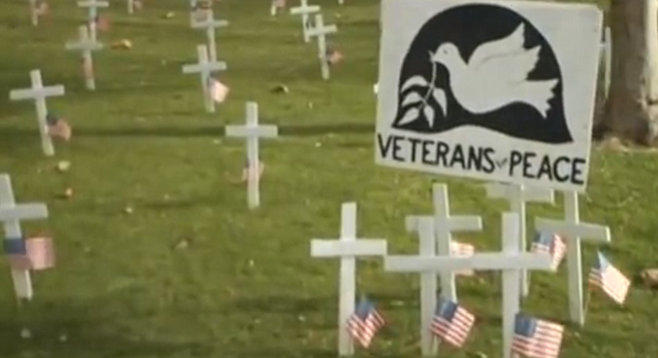 Facebook
Facebook
 X
X
 Instagram
Instagram
 TikTok
TikTok
 Youtube
Youtube

A group of military veterans gathered in front of the Midway museum downtown before the city's annual Veterans Day parade with a display intended to both memorialize and call attention to Southern California soldiers who've died in the Afghanistan and Iraq conflicts of the last 13 years.
"We originally honored all the fallen in Iraq and Afghanistan — we had crosses with individual names of soldiers nationwide, but when that number approached 3000 we couldn't physically carry them anymore," says Gil Field of San Diego Veterans for Peace.
In recent years the display has evolved into what the group calls "Hometown Arlington West," which consists of about 300 tombstone-like markers, each bearing the name of a local soldier from San Diego, Imperial, Los Angeles, or Orange County. They are accompanied by maybe 20 headstones in all black.
"As it turns out, we should have twice as many black headstones as white headstones, more than twice as many veterans die from suicide as have died in the conflict," Field reports.
According to Field, his group's message is twofold.
"Number one, on a day like Veterans Day we're trying to honor the fallen. And we're also trying to educate the public that there is a cost to war. Only about one percent of the nation is directly impacted — most Americans don't have a service member in their families, they don't personally know an active service member."
Field says the reception of Veterans for Peace at events has transformed over the years, from one of hostility to increasing appreciation as public opinion sours on foreign military involvement.
"The feedback has changed significantly over the years. Back when we started doing this, the wars were still moderately popular, so we got pushback from people who felt we were somehow insulting or defaming the fallen by choosing to remember them. In the war's early days, the government didn't even want photos getting out of caskets coming home, they wanted to keep the war away from the public. We took an opposite approach. Today, I would say 99.9 percent of the people have a positive reaction to what we're doing."
Volunteers arrived to begin assembling the headstone display at 8 a.m., they planned to stay through the day's festivities and to disassemble the display at dusk.


A group of military veterans gathered in front of the Midway museum downtown before the city's annual Veterans Day parade with a display intended to both memorialize and call attention to Southern California soldiers who've died in the Afghanistan and Iraq conflicts of the last 13 years.
"We originally honored all the fallen in Iraq and Afghanistan — we had crosses with individual names of soldiers nationwide, but when that number approached 3000 we couldn't physically carry them anymore," says Gil Field of San Diego Veterans for Peace.
In recent years the display has evolved into what the group calls "Hometown Arlington West," which consists of about 300 tombstone-like markers, each bearing the name of a local soldier from San Diego, Imperial, Los Angeles, or Orange County. They are accompanied by maybe 20 headstones in all black.
"As it turns out, we should have twice as many black headstones as white headstones, more than twice as many veterans die from suicide as have died in the conflict," Field reports.
According to Field, his group's message is twofold.
"Number one, on a day like Veterans Day we're trying to honor the fallen. And we're also trying to educate the public that there is a cost to war. Only about one percent of the nation is directly impacted — most Americans don't have a service member in their families, they don't personally know an active service member."
Field says the reception of Veterans for Peace at events has transformed over the years, from one of hostility to increasing appreciation as public opinion sours on foreign military involvement.
"The feedback has changed significantly over the years. Back when we started doing this, the wars were still moderately popular, so we got pushback from people who felt we were somehow insulting or defaming the fallen by choosing to remember them. In the war's early days, the government didn't even want photos getting out of caskets coming home, they wanted to keep the war away from the public. We took an opposite approach. Today, I would say 99.9 percent of the people have a positive reaction to what we're doing."
Volunteers arrived to begin assembling the headstone display at 8 a.m., they planned to stay through the day's festivities and to disassemble the display at dusk.
Comments